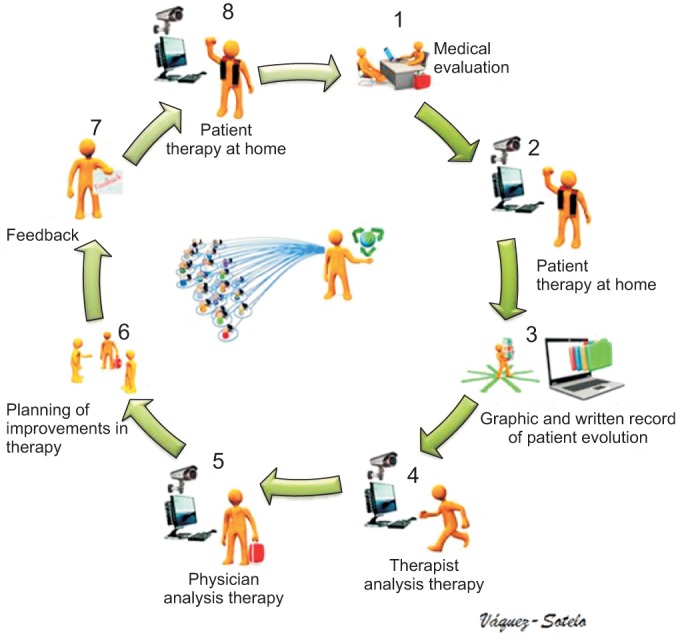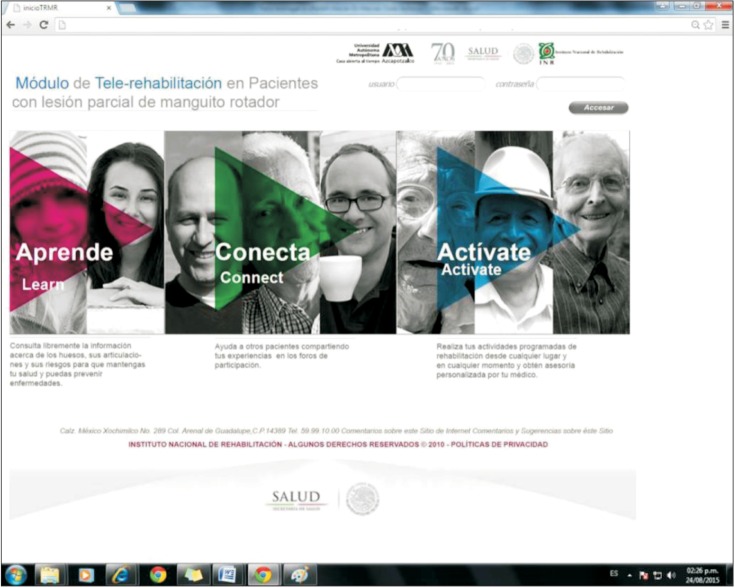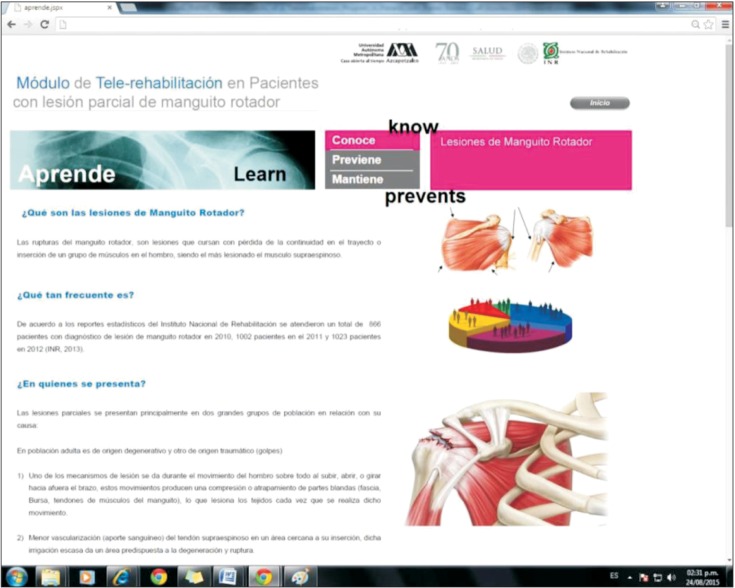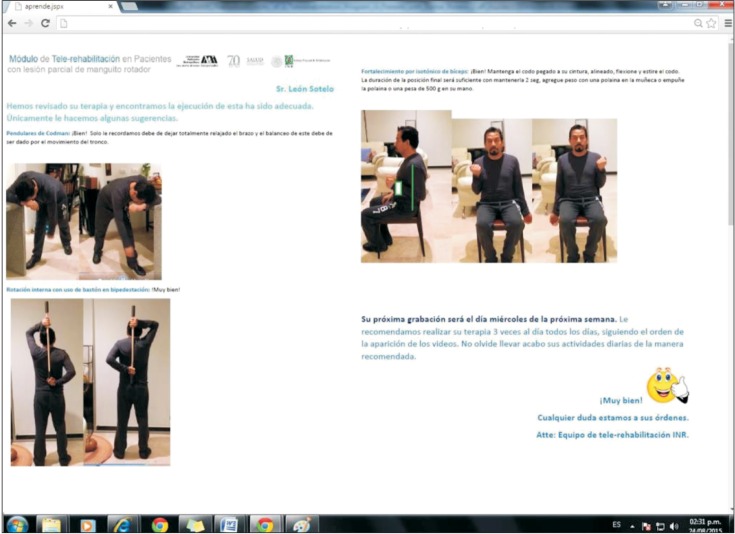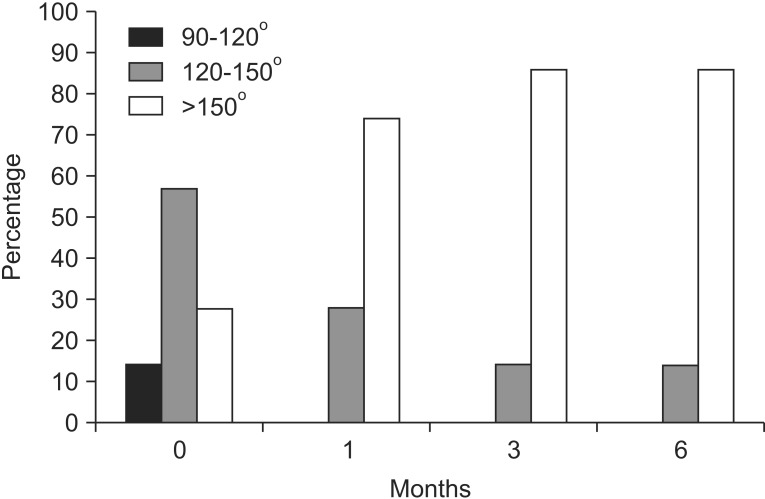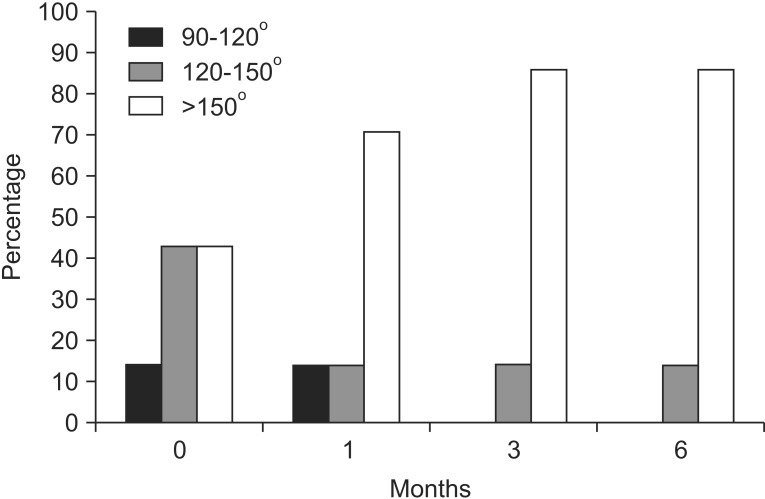Ann Rehabil Med.
2016 Aug;40(4):710-717. 10.5535/arm.2016.40.4.710.
Proposal and Evaluation of a Telerehabilitation Platform Designed for Patients With Partial Rotator Cuff Tears: A Preliminary Study
- Affiliations
-
- 1Orthopedic Rehabilitation Division, Instituto Nacional de Rehabilitación, Mexico City, Mexico. drisraelmacias@gmail.com
- 2Department of Industrial Design, UAM-Azcapotzalco, Mexico City, Mexico.
- 3Subdirection of Technology/Biomedical Engineering, Instituto Nacional de Rehabilitación, Mexico City, Mexico.
- 4Physical Therapy Division, Instituto Nacional de Rehabilitación, Mexico City, Mexico.
- KMID: 2356657
- DOI: http://doi.org/10.5535/arm.2016.40.4.710
Abstract
OBJECTIVE
To propose and evaluate the effectiveness of a telerehabilitation platform designed for patients with rotator cuff (RC) tears.
METHODS
During the first study phase, a virtual service platform that included information on RC tear pathology, joint care, and a series of instructions regarding therapeutic exercise was designed and created. Subsequently, in the clinical phase, a quasi-experimental study was performed. The platform was tested on patients and evaluated at baseline and at 1, 2, 3, and 6 months with respect to their pain levels and functionality on the Constant-Murley (CM) scale.
RESULTS
Eleven patients were included, 5 women and 6 men, with a median age of 55 years (range, 42-68 years). Pain diminished from a baseline value of 64 mm (range, 40-80 mm) to 16 mm (range, 0-30 mm) at 6 months (p<0.001). Points on the CM scale rose from a baseline value of 54 points (range, 51-66 points) to 85 points (range, 70-100 points) at 6 months (p=0.001). Functionality in daily living and work activities, movement, and strength exhibited significant changes at 6 months (p<0.05).
CONCLUSION
Significant changes were observed in pain and functionality in this group of participants who used a telerehabilitation platform. To the best of our knowledge, this is the first study that included a specific program for RC tears.
MeSH Terms
Figure
Cited by 1 articles
-
An Erratum to Correct Typographical Errors
Ann Rehabil Med. 2016;40(5):959-959. doi: 10.5535/arm.2016.40.5.959.
Reference
-
1. Brennan DM, Barker LM. Human factors in the development and implementation of telerehabilitation systems. J Telemed Telecare. 2008; 14:55–58. PMID: 18348747.
Article2. Hailey D, Roine R, Ohinmaa A, Dennett L. Evidence of benefit from telerehabilitation in routine care: a systematic review. J Telemed Telecare. 2011; 17:281–287. PMID: 21844172.
Article3. Rizzo AA, Strickland D, Bouchard S. The challenge of using virtual reality in telerehabilitation. Telemed J E Health. 2004; 10:184–195. PMID: 15319048.
Article4. Hill AJ, Theodoros D, Russell T, Ward E. Using telerehabilitation to assess apraxia of speech in adults. Int J Lang Commun Disord. 2009; 44:731–747. PMID: 18821157.
Article5. Ward EC, Sharma S, Burns C, Theodoros D, Russell T. Managing patient factors in the assessment of swallowing via telerehabilitation. Int J Telemed Appl. 2012; 2012:132719. PMID: 23008704.
Article6. Barr KP. Rotator cuff disease. Phys Med Rehabil Clin N Am. 2004; 15:475–491. PMID: 15145426.
Article7. Littlewood C, May S, Walters S. Epidemiology of rotator cuff tendinopathy: a systematic review. Shoulder Elbow. 2013; 5:256–265.
Article8. Macias-Hernandez SI, Perez-Ramirez LE. Eccentric strength training for the rotator cuff tendinopathies with subacromial impingement: current evidence. Cir Cir. 2015; 83:74–80. PMID: 25982614.9. Moosmayer S, Lund G, Seljom US, Haldorsen B, Svege IC, Hennig T, et al. Tendon repair compared with physiotherapy in the treatment of rotator cuff tears: a randomized controlled study in 103 cases with a five-year follow-up. J Bone Joint Surg Am. 2014; 96:1504–1514. PMID: 25232074.10. Ellman H. Diagnosis and treatment of incomplete rotator cuff tears. Clin Orthop Relat Res. 1990; (254):64–74. PMID: 2182260.
Article12. Clement ND, Nie YX, McBirnie JM. Management of degenerative rotator cuff tears: a review and treatment strategy. Sports Med Arthrosc Rehabil Ther Technol. 2012; 4:48. PMID: 23241147.
Article13. Gomoll AH, Katz JN, Warner JJ, Millett PJ. Rotator cuff disorders: recognition and management among patients with shoulder pain. Arthritis Rheum. 2004; 50:3751–3761. PMID: 15593187.
Article14. Krischak G, Gebhard F, Reichel H, Friemert B, Schneider F, Fisser C, et al. A prospective randomized controlled trial comparing occupational therapy with home-based exercises in conservative treatment of rotator cuff tears. J Shoulder Elbow Surg. 2013; 22:1173–1179. PMID: 23523073.
Article15. Tousignant M, Moffet H, Boissy P, Corriveau H, Cabana F, Marquis F. A randomized controlled trial of home telerehabilitation for post-knee arthroplasty. J Telemed Telecare. 2011; 17:195–198. PMID: 21398389.
Article16. Piqueras M, Marco E, Coll M, Escalada F, Ballester A, Cinca C, et al. Effectiveness of an interactive virtual telerehabilitation system in patients after total knee arthroplasty: a randomized controlled trial. J Rehabil Med. 2013; 45:392–396. PMID: 23474735.17. Kowalczewski J, Chong SL, Galea M, Prochazka A. In-home tele-rehabilitation improves tetraplegic hand function. Neurorehabil Neural Repair. 2011; 25:412–422. PMID: 21372246.
Article18. Piotrowicz E, Stepnowska M, Leszczynska-Iwanicka K, Piotrowska D, Kowalska M, Tylka J, et al. Quality of life in heart failure patients undergoing home-based telerehabilitation versus outpatient rehabilitation: a randomized controlled study. Eur J Cardiovasc Nurs. 2015; 14:256–263. PMID: 24849304.19. Deaton M. The elements of user experience: user-centered design for the web. Interactions. 2003; 10:49–51.20. Van Straaten MG, Cloud BA, Morrow MM, Ludewig PM, Zhao KD. Effectiveness of home exercise on pain, function, and strength of manual wheelchair users with spinal cord injury: a high-dose shoulder program with telerehabilitation. Arch Phys Med Rehabil. 2014; 95:1810–1817.e2. PMID: 24887534.
Article21. Eriksson L, Lindstrom B, Ekenberg L. Patients' experiences of telerehabilitation at home after shoulder joint replacement. J Telemed Telecare. 2011; 17:25–30. PMID: 21075802.
Article22. Safran O, Schroeder J, Bloom R, Weil Y, Milgrom C. Natural history of nonoperatively treated symptomatic rotator cuff tears in patients 60 years old or younger. Am J Sports Med. 2011; 39:710–714. PMID: 21310940.
Article23. Yamanaka K, Matsumoto T. The joint side tear of the rotator cuff: a followup study by arthrography. Clin Orthop Relat Res. 1994; (304):68–73. PMID: 8020236.
- Full Text Links
- Actions
-
Cited
- CITED
-
- Close
- Share
- Similar articles
-
- Partial-thickness rotator cuff tears: a review of current literature on evaluation and management
- Partial-Thickness Tear of Supraspinatus and Infraspinatus Tendon Revisited: Based on MR Findings
- Comparative Study of MR-arthrography and Arthroscopy in Partial Thickness Rotator Cuff Tears
- Current Concept of Management of Partial-thickness Rotator Cuff Tear
- Clinical Features and Arthroscopic Findings of Partial Thickness Rotator Cuff Tears

